Contact and call center coaching: Beginners vs tenured managers

VP of Customer Experience

Tags
Share
One of the most important responsibilities for a contact center or call center manager is to make sure that their agents have all the resources they need to succeed.
There are many different ways to do this, from individual or group coaching sessions to even automations that let you do coaching at scale.
Having spent over 15 years in support and customer success, I’ve pulled some insights and tips that any contact center managers can use to coach agents and help them feel empowered in their roles.
What is coaching in a call center or contact center?
Contact center coaching is pretty much what it sounds like: the process of training your agents or reps to make sure they’re performing at the highest level possible. These could be customer support agents, sales reps, employee support agents, and so on—it’s not always just about customer support.
There are a variety of ways to go about contact center coaching, depending on who you’re training and what you want them to learn. You could be training new hires from scratch or upskilling existing agents with new techniques.
It could involve group activities such as seminars or best-practice activities to bring a whole group of agents up to speed with new skills or procedures.
When it comes to contact center coaching, one important thing to remember is to set performance metrics—and monitor them regularly over time. This way, you’ll know whether your coaching sessions are actually effective.
And the last thing (which many supervisors forget about) is to ensure that your agents understand why the improvements are needed and what’s expected of them. Agents who know this information tend to be more likely (and able) to look at their own performance and proactively spot where they can make improvements—and that’s what we want as managers!
The overlooked benefits of good call center coaching
Yes, it keeps your customers happy, but there are other benefits too.
It can help build trust and improve employee engagement
Employee engagement is incredibly important because it not only directly impacts your customer experience, but also can raise the productivity of your operations.
When agents feel supported and empowered (the results of good coaching), that often leads to a higher level of employee engagement and retention, lower turnover, and ultimately, improves call center performance.
It makes it easier to hit your targets
Speaking of performance, good coaching can also directly impact your KPIs (key performance indicators).
This is probably what most leaders care about even more than employee engagement. No matter what metrics and KPIs you measure your contact center against—whether it’s FCR (first contact resolution), average handling time, and so on—effective coaching is essential to meeting and exceeding those targets.
Have an action plan for every agent (even the good ones likely have areas they can improve on), and meet with them regularly to review what’s going well and where they’re struggling. They may seem like small things, but they can go a long way in making sure your coaching sessions have a visible impact.
It contributes to a positive brand image
In companies and organizations where contact centers are customer-facing, effective coaching that leads to good customer experiences will manifest itself in the form of your brand reputation.
Good coaching leads to happier customers who are more likely to provide positive reviews—and recommend your businesses to their friends, coworkers, and other contacts. It’s a virtuous word-of-mouth cycle.
👉 Quick tip:
Some supervisors tend to overly focus on one or the other, but both positive feedback and negative feedback can provide valuable coaching opportunities.
A few effective coaching techniques
Of course, there are different ways to coach agents, and each supervisor may prefer different methods. Here are a few approaches that I’ve found work well, especially when combined in an overall coaching strategy.
Real-time coaching
Real-time call coaching is where supervisors or managers coach front-line agents live as they are on real calls with customers, prospects, students, employees, or whatever audience they’re communicating with.
Because this method involves dealing with actual people with real queries, it can be a bit scary for the agent, which is why you’d likely use this method with folks who’ve had a bit of training already—but it provides a great opportunity to see how the agent performs under pressure.
Most managers will listen to calls in the background to do real-time coaching—but what if you’re overseeing a team of agents who are all on simultaneous active calls? You could sit on each call for a few minutes and cycle through the list of calls continuously, but that can get exhausting quickly, and you’d only hear snatches of conversations here and there.
What if, instead, you could see real-time transcripts for each call?

And what if managers could see the sentiment of each call and quickly see where they might need to jump in and help the agent?
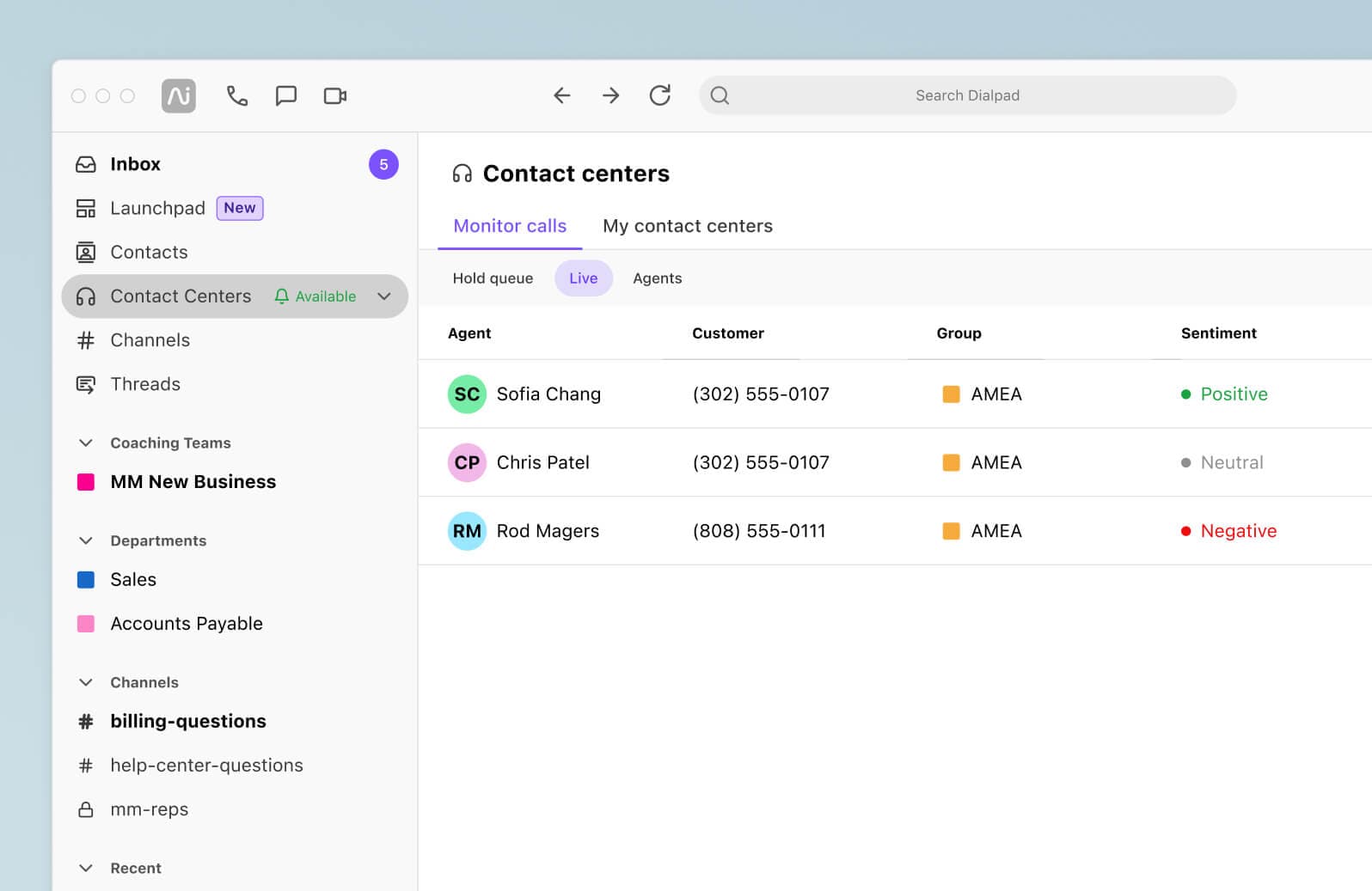
Our CX team uses Dialpad's cloud contact center solution to do both, and love that they’re able to more easily coach agents at scale, while getting full context into conversations.
📚 Further reading:
Learn more about contact center and call center management in this guide from our Customer Support team lead.
Automated coaching
Another way of coaching call center agents is, interestingly, not by directly coaching. (Not technically, anyway.) Agents still get what they need to have successful conversations, but this is a much less time-consuming method. It’s calledcall automated coaching.
The best way to illustrate automated coaching might be through an example. Let’s say a customer support supervisor knows that agents are getting tripped up by questions about feature X.
In Dialpad, they can then take these roadblocks and create RTA (Real-time Assist) cards with tailored notes on “feature X” and set them to pop up automatically on agents’ screens as those questions come up on calls:
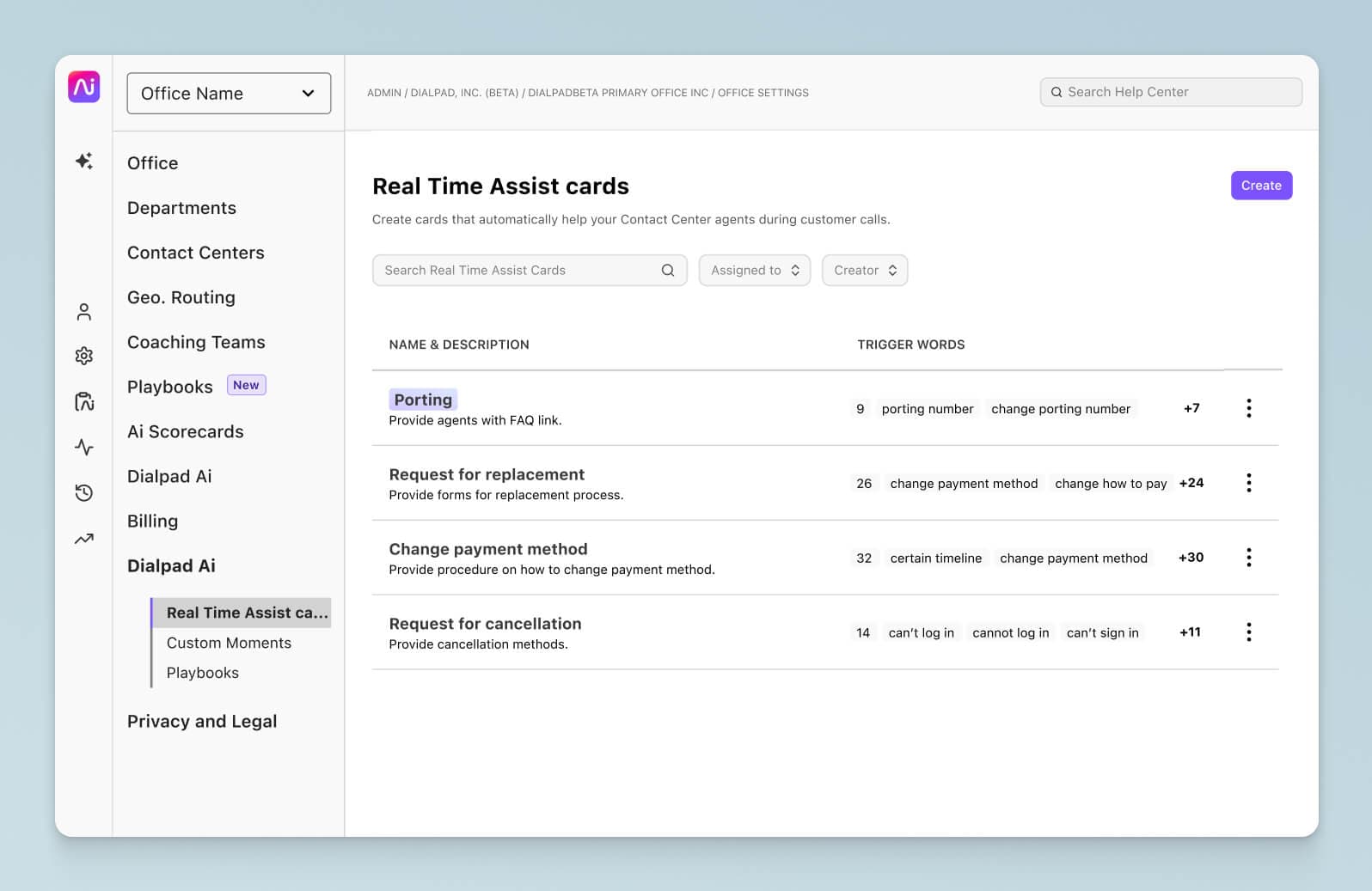
Whether you’re onboarding new call center agents or keeping your seasoned agents aware of the latest updates in your products or services, this type of AI-powered, automated coaching is a low-effort approach that’s massively scalable.
One-on-one coaching sessions
Finally, between all the active calls, coaches should follow up regularly with call center agents to make sure that any positive or negative feedback is being addressed consistently.
This is where supervisors can really vary in their styles and approaches—some may switch roles and coach through role-play, while others may encourage agents to lead the discussion and focus more on active listening instead.
The main thing here is to maintain consistency. To be successful, coaching should be regular and ongoing. Regular, because it lets managers catch any slip-ups or adjustments that agents may forget about if not reminded of them, and ongoing, to make sure that agents stay up to date on the latest changes in the company or industry.
3 call coaching approaches: beginner vs. tenured managers
Now, let’s look at how different types of contact center supervisors approach the same coaching tasks. This comparison is helpful because it can shed light on common mistakes and other learnings that often, you won’t know about until you’ve spent those years in contact centers.
1. Using data
How beginner managers use data
Large call centers generate a ton of data, which can seem overwhelming. For new managers, it can be hard to know what to make of it all, and which metrics to focus on.
For example, a relatively new manager may see a series of long call times on an agent’s record and assume that they’re failing to deal with customers in a prompt manner. The manager might end up going down a rabbit hole trying to find out what’s happening with that team member—are they putting the caller on hold? Going round in circles to solve the issue?
This can lead to them concentrating too much on one set of performance data in a vacuum with no context.
How tenured managers use data
It’s important to remember that a call center generates two sets of data: real-time and historic. A more experienced manager will realize that these shouldn’t be viewed as separate entities—it’s better to analyze both sets together.
Following on from the example above, a more seasoned manager may see a series of abnormally long call times and investigate what other factors may be at play—instead of automatically assuming the agent is at fault or that it’s an agent performance issue.
For example, they might use the historic call data to compare call times, and try to see if the high call time is just an anomaly. If the overall times are fine, there’s no need for panic. Ideally, you’d have a contact center platform that alerts you automatically when service levels drop—like with Dialpad:
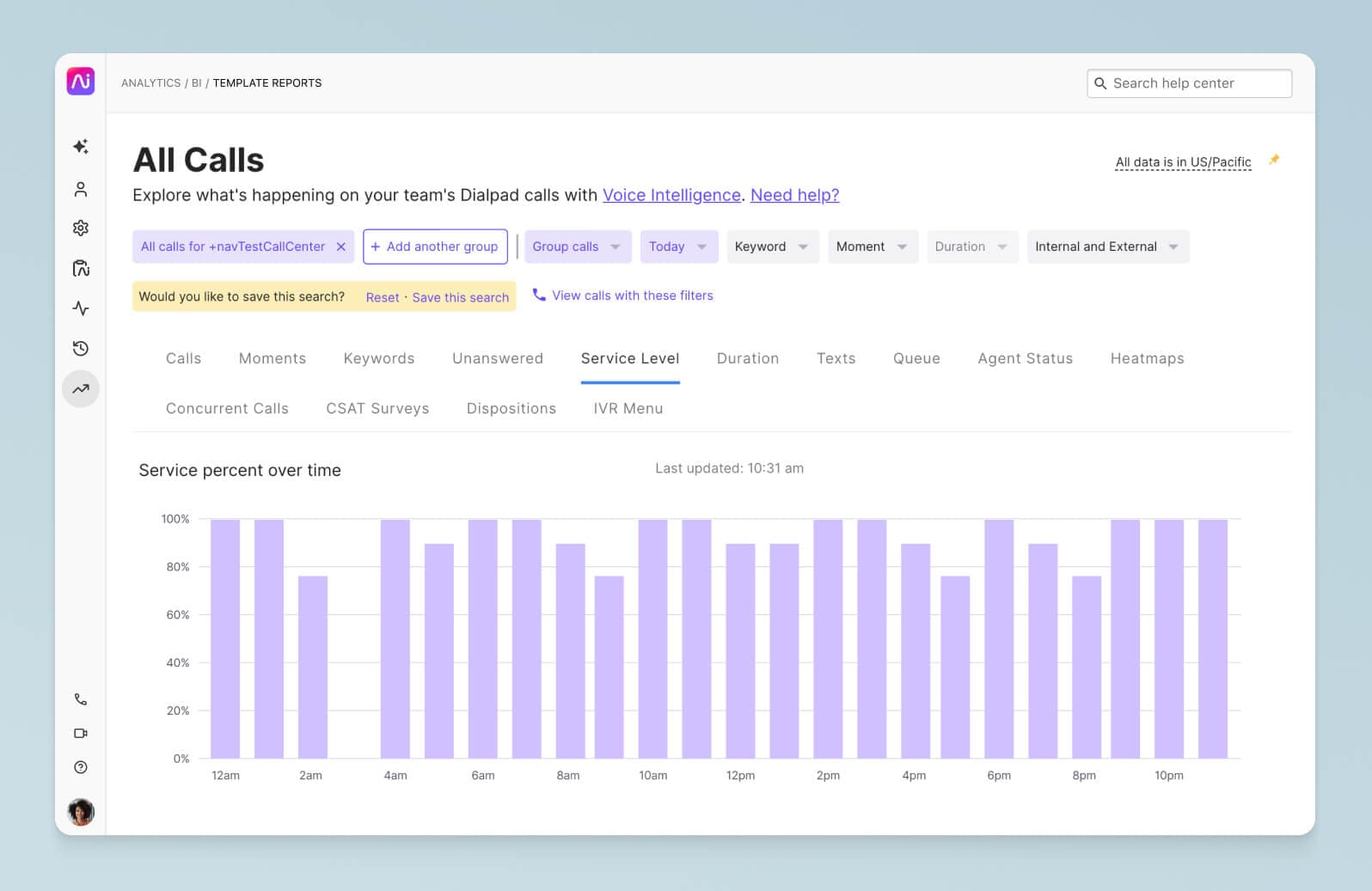
2. Looking for root causes of problems
How beginner managers spot problems
This is closely related to the approach above, but a beginner manager may experience something we call “dashboard shock,” which is when they’re checking their dashboards and suddenly spot a metric that rings alarm bells.
Usually what happens is they’ll want to jump in right away and “fix” the supposed roadblock, without getting more context. For instance, they might approach a particular agent and start listening to their calls, when that may not be necessary.
How tenured managers spot problems
As I mentioned above, anytime we’re working with data, it’s important to be aware that there can be a huge variety of circumstances which affect things like call length and resolution rates, independent of an agent’s skill set or individual performance.
If call times are becoming longer in general, it could mean that there is an emerging fault with a product or service which is impacting customers. Has there been a recent glitch or a recall that generates complaints or requires more complex tech support?
A tenured manager will know to maintain a big-picture view of not only the overall contact center, but even the industry as a whole. That’s the level and breadth of context that we often need.
Rather than singling out an agent or group of agents for long call times, an experienced manager might do a quick pass of their call recordings and transcripts. Was it a particularly difficult customer? Or is there a knowledge gap?
With Dialpad, for example, not only do we have real-time transcripts and call recordings, but we can also create playlists of the best (or worst) examples of different types of calls. This way, agents can learn at their own pace using actual conversations our teams are having every day:
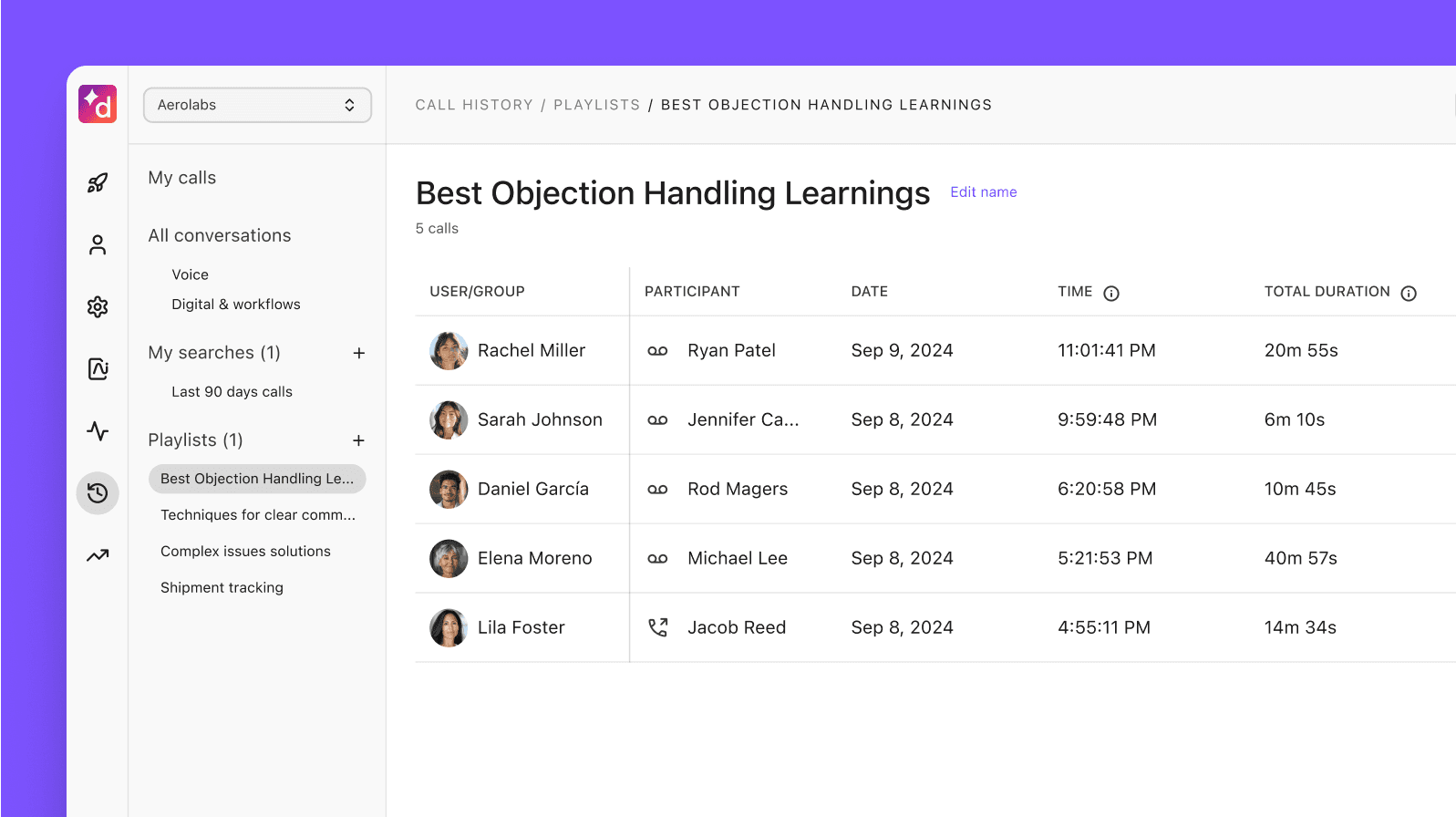
3. Delivering the right coaching—to the right people
How beginner managers deliver coaching
One of the biggest learning curves for a beginner manager (who may have been a star call center agent and has now been promoted) is adapting to the different requirements of being a supervisor or manager.
Things that may have been an everyday habit before—focusing on minute details, trying to personally handle every call—can end up being detrimental and a cause of micromanaging behavior in a supervisor.
Another common challenge for a new manager is using active listening and learning how to adapt generic coaching advice and tailor specific examples to different agents who have different skill sets, personalities, and learning styles. It can be tempting to spend all your time on the agents who are struggling—but even top performers can benefit from thoughtful, considered coaching.
How tenured managers deliver coaching
A tenured manager, in comparison, has a good grasp of who needs coaching at what time—and what type of coaching is needed. Whether they have abundant resources and a targeted coaching program or whether they’re part of a smaller team, a seasoned coach knows they have to consider how different agents receive feedback, whether positive or negative.
Of course, having the right tools can be very helpful and make the job easier (for example, gamification or an online knowledge base).
How we use Dialpad as call center coaching software
Identify coachable calls
To find coachable calls, we can look in the call logs. Dialpad’s Call History menu makes this relatively easy by displaying a running list of calls to dive deeper into. We can then use filters, to focus on calls containing positive or negative sentiment, for instance, and understand why customer satisfaction levels dipped.
If a manager wanted to, they could filter out all calls with negative sentiment and scan the transcripts to quickly pick out good candidates for coaching.
Use Ai Scorecards as scalable call center agent coaching forms
QA Scorecards are a common way for supervisors and coaches to listen to agent calls and understand if they’re adhering to prescribed behaviors. The problem is the scale with which coaches can listen in—there’s no realistic way to listen to every customer call, so providing tools that allow for scale is incredibly important.
That’s where Dialpad’s Ai Scorecards come in. They're an incredibly useful tool that helps contact center supervisors and QA teams scale call reviews and provide objective feedback to agents quickly.
Supervisors and admins can easily create a QA Scorecard, and as the contact center agent handles calls, Dialpad Ai listens to each interaction and automatically suggests when the scorecard behavior is met:
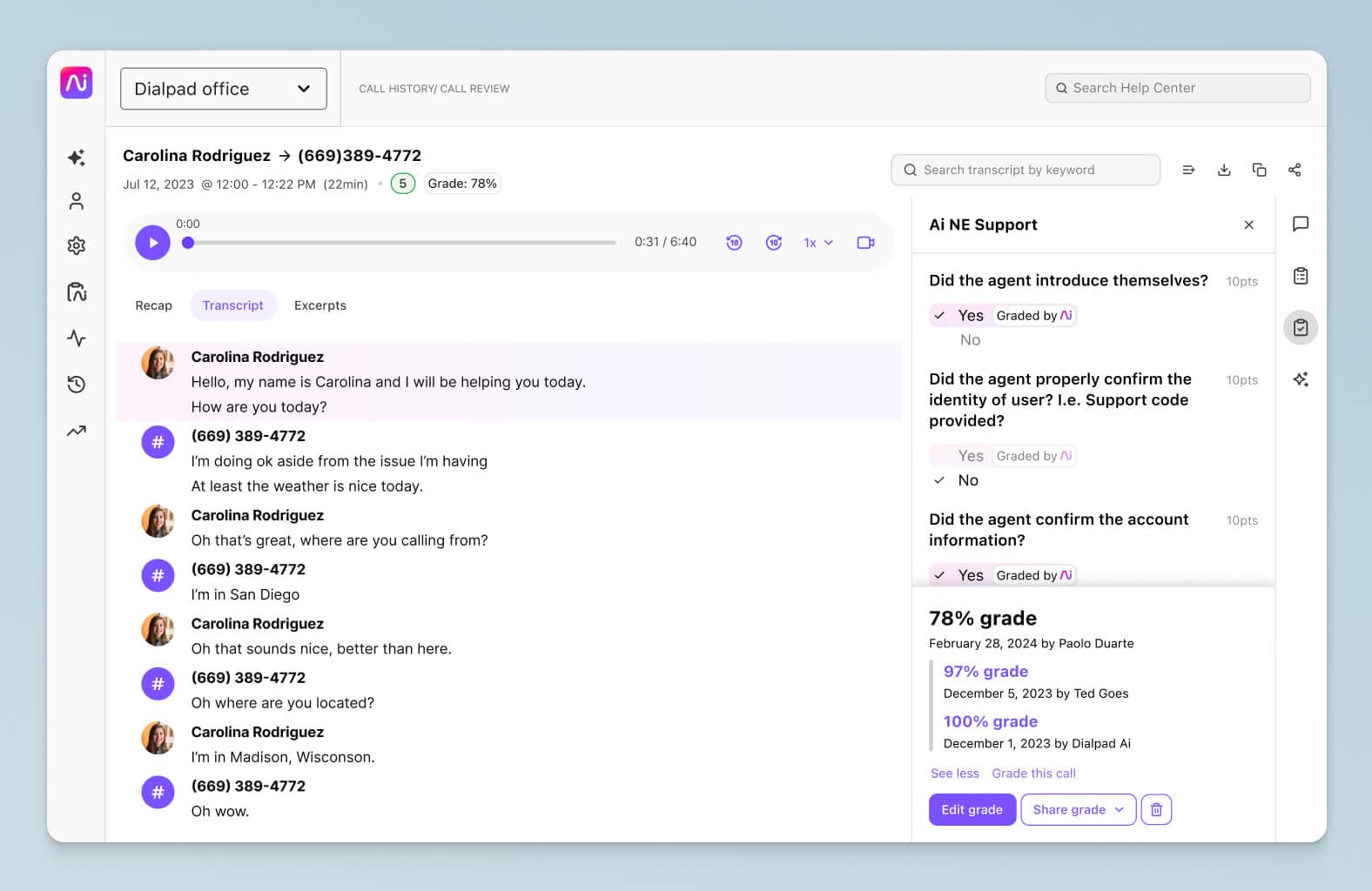
For example, the scorecard behavior might be “Agent asked the customer for their email ID.” If the agent asks for the customer’s email, whoever grades that call will immediately see that the activity was completed, without having to listen to the entire call recording or read the transcript.
This allows contact center teams to scale QA reviews across a much wider range of calls than would otherwise be possible—in turn, this means more effective agents, happier customers, and much improved customer satisfaction metrics.
Drill down to specific moments
Dialpad’s AI makes it possible for us to glean much more insight from verbal conversations. Whether we want to dig deeper into customer requests for refunds or see how often competitors come up on sales calls, there’s no “guessing game” to play—we can easily pull these details about customer interactions out of every call.
To do this, we simply create “Custom Moments” to track those keywords, and these occurrences will then show up in our analytics dashboard—it’s a helpful tool for any call center:
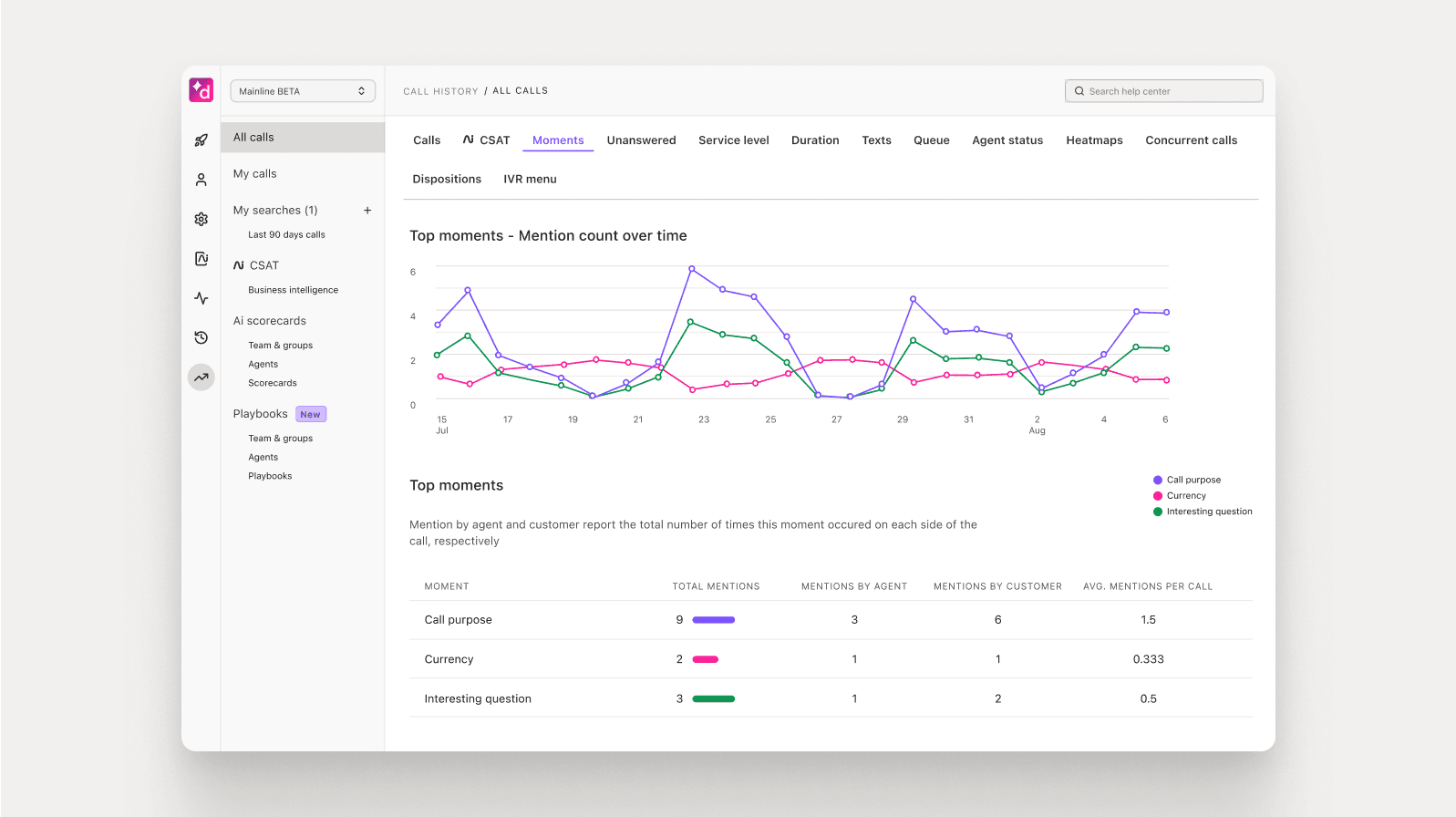
From here, we can gather these common questions or tricky topics and both scale quality assurance and better prepare our agents with Real-time Assist cards (RTAs).
Create playlists for training and onboarding
To do training at scale, we collect great examples of calls into a playlist for coaching, and tailor each playlist’s theme to focus on a different area.
Another way to use playlists is to have agent-specific playlists. It’s a great way to look at an agent’s growth over the course of a quarter or a year—where have they made improvements and implemented your feedback? Or did they make no changes at all?
If you can instill this habit in your call center agents of continuous self-paced learning, it will complement your coaching sessions well (and maybe even lighten the load on supervisors a bit).
Live-coach calls
Finally, we use Dialpad to do live-coaching. Supervisors can shadow agents on calls no matter where they’re located, since it’s a virtual call center platform, and can easily message agents with helpful tips on the side.
Because Dialpad has speech and conversation analytics and automation features like the RTA cards, supervisors can prioritize their live coaching for conversations that are more complex or that don’t currently have RTA cards associated.
For example, let’s say one of our managers sees two active calls with negative sentiment, and after scanning the transcripts for both, deduces that one customer has a question about porting phone numbers over and the other customer has a very complicated question about custom pricing packages.
And let’s say this manager knows that custom pricing can vary quite a bit and require more explanation—but they did recently create an RTA card specifically about porting numbers to help agents talk through the process with customers.
The manager could probably safely prioritize helping the agent who’s handling the customer with the custom pricing question, and let the automation handle the other call about porting numbers!
Ready to improve agent performance and transform your call center coaching?
Good coaching is key to not only a better customer experience, but also happier and more empowered agents—and a smooth-running operation.
And today, there are so many useful coaching tools and call center software that can make it easier to coach more agents, more effectively. Use them to transform your contact center coaching!
Looking for a way to improve your call center coaching and agent experience?
Book a personal walkthrough to see how Dialpad Support can help, or take a self-guided interactive tour of the app on your own first!
